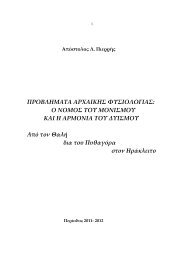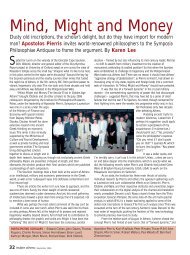chapter 10 the monism of darkness and the dualism of limit and ...
chapter 10 the monism of darkness and the dualism of limit and ...
chapter 10 the monism of darkness and the dualism of limit and ...
You also want an ePaper? Increase the reach of your titles
YUMPU automatically turns print PDFs into web optimized ePapers that Google loves.
70 CHAPTER <strong>10</strong><br />
The image <strong>of</strong> a serpent fits rivers <strong>and</strong> <strong>the</strong> Ocean is <strong>the</strong> very first<br />
river, source <strong>of</strong> rivers <strong>and</strong> <strong>of</strong> all unsalted waters <strong>and</strong> <strong>of</strong> <strong>the</strong> sea.<br />
Acheloous is thus represented, Sophocles, Trachiniae, 11-2, Ovid,<br />
Metamorphoses IX, 62 sqq. (In <strong>the</strong> red-figured stamnos <strong>of</strong> British<br />
Museum (B471) we see <strong>the</strong> battle between Hercules <strong>and</strong> Acheloous in<br />
which <strong>the</strong> latter is painted as a snake with human head, arms <strong>and</strong><br />
h<strong>and</strong>s <strong>and</strong> a fish tail; Corpus Vasorum Antiquorum, Br. Mus. 3, III<br />
1C, Plate 19, 1b). The continuous flowing <strong>of</strong> rivers resembles <strong>the</strong><br />
continuous legless movement <strong>of</strong> serpents. Already in <strong>the</strong> Homeric<br />
cosmic geography <strong>the</strong> Ocean is a river (Ilias Ξ 245-6, Σ 607), a current<br />
(ÚfiÔ˜ O 151) with no source, but one that comes back to itself in a<br />
full circle (as it is represented in <strong>the</strong> famous iconography <strong>of</strong> Achilles’<br />
shield at <strong>the</strong> outer cirmumference <strong>the</strong>re<strong>of</strong>, Ilias Σ 606-7:<br />
\EÓ ‰b Ù›ıÂÈ (sc. ≠HÊ·ÈÛÙÔ˜) appleÔÙ·ÌÔÖÔ Ì¤Á· Ûı¤ÓÔ˜ \øηÓÔÖÔ<br />
ôÓÙ˘Á· appleaÚ apple˘Ì¿ÙËÓ Û¿ÎÂÔ˜ apple‡Î· appleÔÈËÙÔÖÔ.<br />
The adjective à„fiÚÚÔÔ˜ that characterizes <strong>the</strong> Ocean Σ 399,<br />
Odyssey ˘ 65, signifies <strong>the</strong> coming-back-to-itself <strong>of</strong> <strong>the</strong> current that<br />
encloses <strong>the</strong> earth (cf. Eustathius, In Dionysium Periegetam 1, GG II<br />
217, 15). Crates rightly insisted on <strong>the</strong> flowing-riverness <strong>of</strong> <strong>the</strong> whole<br />
Ocean against some rationalistic tendencies à la Poseidonius which<br />
assumed that <strong>the</strong> Homeric image refers to <strong>the</strong> oceanic ebb <strong>and</strong> flow (v.<br />
Strabo, Geographica, A, 1, 7).<br />
According to <strong>the</strong> Gnostic text Pistis-Sophia 319 sqq. (p. 207 sq. ed.<br />
W. Till, German translation <strong>of</strong> <strong>the</strong> Coptic original), <strong>the</strong> outer<br />
Darkness that envelops <strong>the</strong> World is a Large Dragon whose tail is in<br />
his mouth. He is <strong>of</strong> course <strong>the</strong> acclaimed Uroboros whom we also find<br />
in <strong>the</strong> Magical Papyri (cf. Preisendanz, Papyri Graecae Magicae 2 , VII,<br />
586 sqq. vol. II p. 26 <strong>and</strong> picture in Table I, 4). Cf. Pap. Gr. Mag. IV,<br />
2769-71 vol. I, p. 160: ëappleÙa ñ‰¿ÙˆÓ ÎÚ·ÙÂÖ˜ ηd Áɘ ηd ÛÎfiÙÔ˘ nÓ<br />
Î·Ï¤Ô˘ÛÈÓ ‰Ú¿ÎÔÓÙ· ̤Á·Ó (with Wuensch’s emendation ηd ÛÎfiÙÔ˘<br />
instead <strong>of</strong> <strong>the</strong> meaningless papyrus reading ηÈÛÎ (j ¯)ÔÔÓÔÓ.<br />
Dieterich, Abraxas p. 123, presents —building upon Miller— a verse<br />
in hexametre: ≤Êı’ ñ‰¿ÙˆÓ ÎÚ·Ù¤ÂȘ ηd Á·›Ë˜ ä‰b ÛÎfiÙÔÈÔ).<br />
The Orphic <strong>the</strong>ology according to Hieronymus <strong>and</strong> Hellanicus<br />
(OF 54 from Damascius De primis principiis 123 bis, I 317, 15










